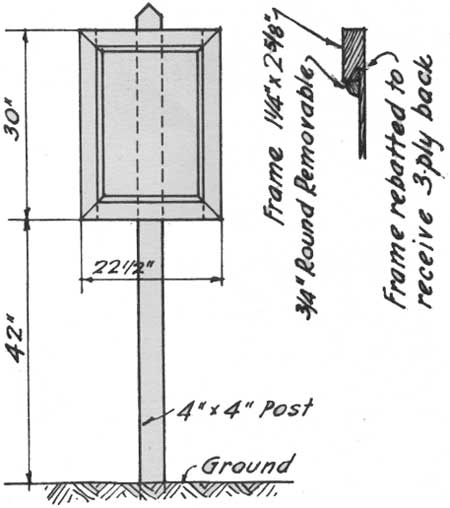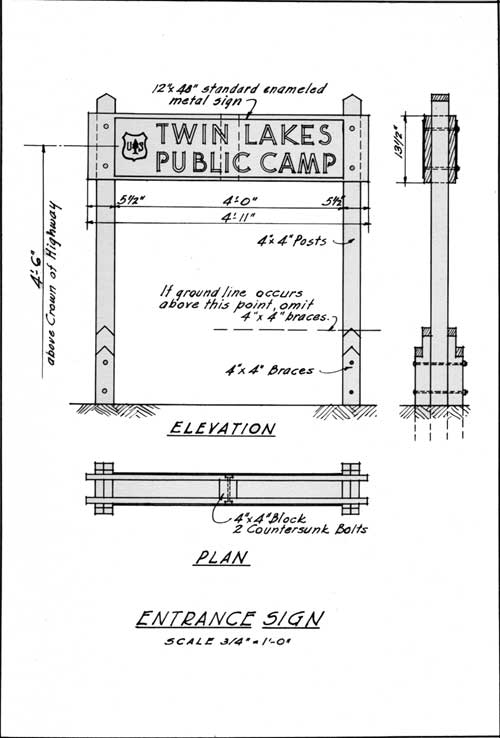|
Public Camp Manual
|

|
NATURE AND ORDER OF IMPROVEMENTS
VIII. SIGNS
The proper choice and placing of signs in public camps will do much toward improving the area from a camper's viewpoint. In the past, there has been a tendency to "over-sign" our camps. This should be guarded against. A few signs appropriately worded and strategically placed, will much better serve our purpose. No signs shall be placed on trees.
Bulletin Boards: Every improved public camp shall have one or more well-located bulletin boards, on which the "Camp Ground Rules" sign shall be placed. This sign covers all the subjects mentioned on the 7" x 14" yellow and black signs and looks much better than does a collection of these signs tacked on a large board. (See sketch below).
Camp Ground Limits: The yellow and black camp ground limit signs shall be posted on the boundaries of all camps where use is restricted to the improved area. This applies particularly to areas of high fire hazard. Limit signs should be so located that from any particular sign, the signs on either side may be seen. These signs should be posted on 4" x 4" redwood posts and should be 5' above the ground.

|
| Bulletin Board |
Entrance or portal signs: All camps should have entrance signs on the highway. These shall be of the standard metal enamel type, giving the name of the camp. Hereafter, they should be mounted as shown in the adjoining sketch.

|
| (click on image for a PDF version) |
Garbage, Water, Toilet. etc.: The Regional standard signs shall be used in marking locations of garbage cans or pits, water hydrants or wells, and toilets. In the case of garbage cans and hydrants, signs should be placed as indicated in discussion of those items. It will be necessary in many cases to post small direction signs to guide visitors to these improvements, in which event the signs shall be low, not more than two feet above the ground.
Public Service Site: Where there is likelihood of mining locations being made on a camp ground, the area shall be posted with Public Service signs marking the boundaries of the area desired for camp development.
Road: One-way roads shall be marked with arrows or with "one-way" and arrow signs. These shall be placed on low posts, not more than two feet above the ground.
Special: Where special signs are required and they are made locally, standard colors should be used and the signs made to conform as closely as possible to the Forest Service standards for special signs.
Toilet Signs: One of the standard printed "toilet" signs shall be placed inside each toilet building, whether of the pit, chemical, or flush type.
Tree Identification: In certain camps it may be desirable to identify individual trees by fixing small, inconspicuous tags or signs, bearing the name of the particular species represented. This has proven quite popular wherever it has been done, and the practice should be extended.
All camp ground signs shall be replaced whenever they become weather-worn or mutilated.
Quantity purchase of camp ground signs will be made annually by the Regional Forester. While as a general rule these signs will be of wood, metal enamel signs of similar size may be purchased for posting on latrines and other structures that are of a permanent nature.
| <<< Previous | <<< Contents>>> | Next >>> |
|
region/5/public-camp-manual/sec4-8.htm Last Updated: 11-Jan-2010 |